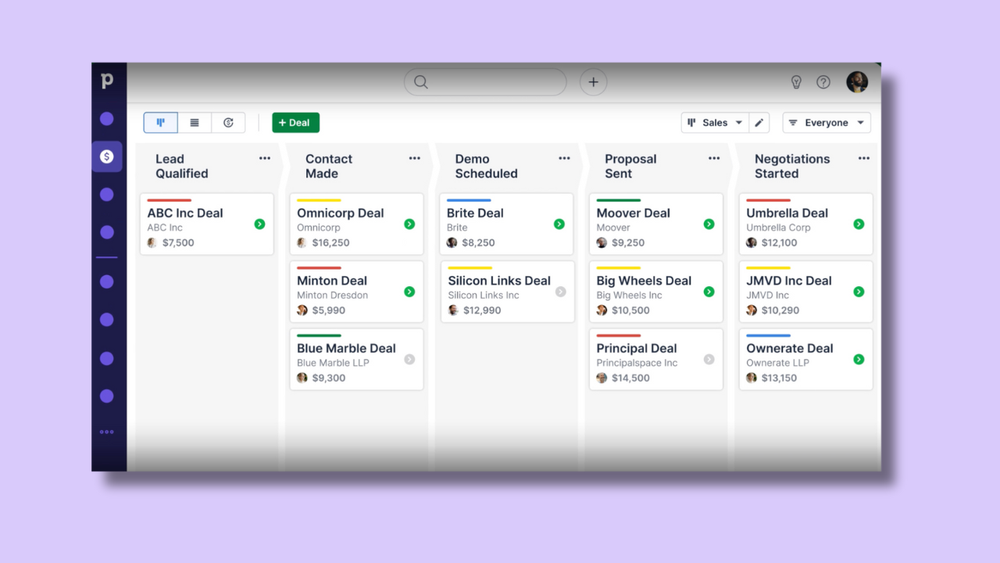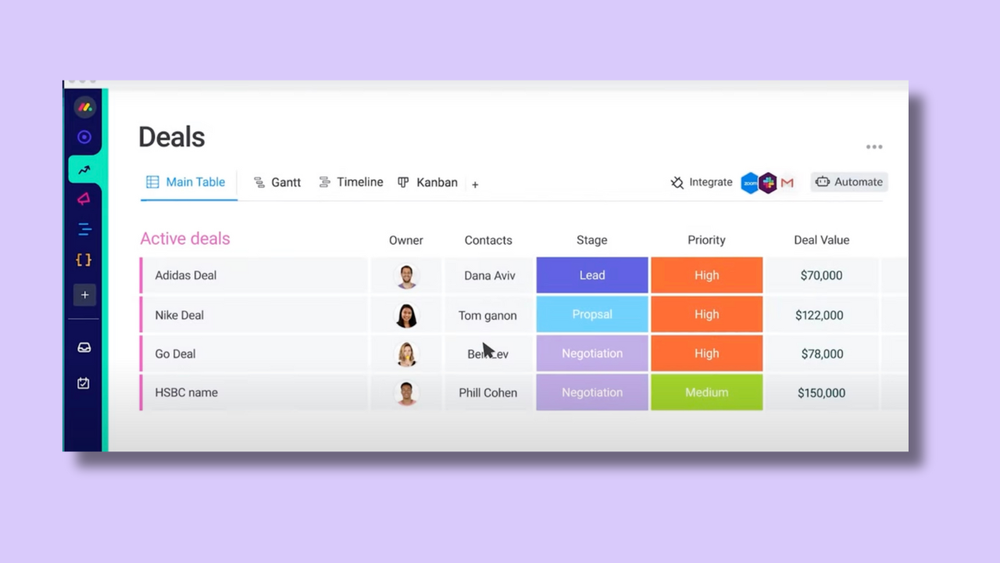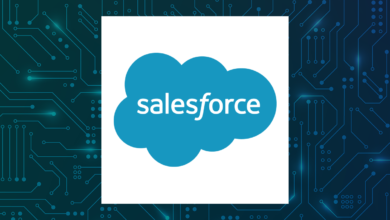Pipedrive vs. monday: Which is best in 2024?

A famous mantra associated with sales is “always be closing.” Yet that cut-throat perspective has been replaced more recently with a focus on customer relationship management (CRM) throughout the sales cycle. CRM software can help your business streamline its customer relationship process by giving you tools to track and manage prospects, leads and customers, as well as features to engage with them in personalized ways.
This article compares two popular cloud-based CRM platforms, Pipedrive vs. monday.com, to help you determine which would work best for your team.
Starting paid plan price
$10 per user per month (billed annually with a minimum of 3 users)
Ease of use (based on user reviews)
Excellent
Starting paid plan price
$18 per month
Ease of use (based on user reviews)
Above average
Pipedrive vs. monday snapshot
To give you a quick overview, here’s what you need to know about Pipedrive vs. monday.com at a glance.
Pricing and plans
You’re in business, so budget matters. This section breaks down the CRM pricing and plans available, comparing pricing based on monthly billing.
Note: You can save on these plans by paying on an annual basis.
Pipedrive
Pipedrive’s plans are priced per seat, per month, with no minimum or maximum seats per plan. There is a discount if you choose annual billing instead of monthly.
With five offerings, Pipedrive has plans for every business size and budget. Deciding which one suits you means considering what your process is like now and what you want it to be. At the Essential level, you can have 3,000 open deals and 30 custom fields (both per company), and you’ll get 15 reports per user. With Advanced, your deal, custom field and report limits are raised plus you can automate more of your administrative processes and gain the ability to synchronize the CRM with other software (e.g., Google Calendar and Gmail or Outlook).
Professional, Power and Enterprise plans offer your salesforce increasingly more ability to customize your pipeline to your specific sales process with AI-backed workflow automation. Power layers in tools to collaborate on task management and business communication, while Enterprise provides enhanced access controls and other security features.
monday.com
While monday.com’s plans are also priced per seat, there is a minimum of three seats at the entry level; the next option has a minimum of five seats, and it goes up in increments of five or 10 seats after that.
With the Basic plan, you get unlimited boards, docs, messages and updates, iOS and Android apps and 200+ templates. The Basic plan offers only one week of activity logging, while the other plans offer six months to five years as you pay more. Where you really see the Standard, Pro and Enterprise plans pull away is in the integration and automation features. The Enterprise level also provides enhanced security measures unavailable in the other plans.
Verdict: Your number of users matter
Comparing the price and plans for these two CRMs requires you to consider not only which features and functions you want but also how many users. The plans are pretty evenly matched price-wise, but Pipedrive may be more budget-friendly for small teams as you don’t have to pay for seats you aren’t using.
Key CRM features
Both Pipedrive and monday have tools to support your sales pipelines and customer interactions. This section outlines the key features to consider when comparing the two.
Pipedrive
Pipedrive’s CRM consolidates your leads, deals and customers to give you access to your full pipeline in one place. You’ll be able to visualize progress through the sales funnel and customize what you see on your dashboard to better understand your sales cycle and keep track of all your various tasks and activities.

Communication is streamlined with the ability to sync your pipeline and email. Plus, sales teams can call customers directly from the CRM on their mobile devices.
Other useful features for sales include the ability to:
- Import from spreadsheets or from other external channels via contact Sync
- Identify those at risk of growing cold with deal rotting
- Get live notifications when contacts click or open emails
Pipedrive also offers a wide range of quick video tutorials as well as courses and webinars to help you optimize your CRM.
Note: Pipedrive touts its live chat, chatbot and web form features, but these are part of the add-on LeadBooster. You’ll pay an extra $32.50 per month per company for this tool that helps you capture inbound and outbound leads.
monday
The monday.com CRM is one of three products on an overall platform designed to support work management (with additional project and resource management and product development lifecycle offerings). The platform is built on a no-code framework so you can easily customize the CRM software to your needs with a drag-and-drop interface, or choose from 200+ prebuilt templates.
As you’d expect from any CRM, monday collects all your leads in one place where they can be automatically scored based on your custom criteria. Then, you can track all contact and account information in the deal pipeline while easily performing and logging activities (such as sending emails, qualifying contacts and scheduling meetings) from within the CRM.

Other useful features for sales allow you to:
- Personalize bulk emails
- Automatically duplicate data merging
- Gamify your sales efforts with a leaderboard widget
As you level up your plan, you have greater dashboard access to deal progress, sales figures and team performance. The monday CRM also offers post-sales management and sales operation tools (e.g., collection tracking, headcount planning and sales team onboarding), but only at the enterprise level.
Get up to speed on how to use your monday features with the range of articles, explainer videos, course work and technical documentation available in the help center.
Verdict: Pipedrive puts CRM first
Pipedrive was designed for and continues to focus on CRM, offering users tools that help throughout the sales process. Meanwhile, monday started out as a work management system and only added its CRM product in 2022. While monday may be easier to pick up and customize to your specific needs with its no-code framework, Pipedrive has a more dedicated and long-term sales focus you can leverage as your business grows.
Integrations
A big benefit of CRM software is that it consolidates all your sales and marketing information in one place, giving your employees easier access to data about purchase history, customer service interactions, client goals and more. The ability to integrate your CRM with other tools your business uses regularly can further enhance the value of the platform you choose.
Pipedrive
You can choose from more than 400 integrations in the Pipedrive marketplace, which are accessible on any of the pricing plans. To make it easier for you to find what you need, you can look for apps based on revenue cycle stages (e.g., “manage my projects,” “nurture my leads” or “support my customers”). You can also search by name for a tool you know you love or see which apps are recommended by Pipedrive based on your industry, location and other factors.
monday
This CRM’s 200+ integrations are available only to users on the Standard plan or above. Even in the Standard plan, your integration options are more limited, and integration actions are limited to 250 per month. It isn’t until you are a Pro or Enterprise customer, for example, that you can access MailChimp, HubSpot and Facebook Ads integrations. The Salesforce integration only comes at the Enterprise level. You can browse monday’s app marketplace by category, editor’s choice or what’s trending.
Verdict: Pipedrive makes integration easy
Taking a tiered approach to integration access puts monday.com behind Pipedrive in this area. With so many options available and access open to any plan’s users, Pipedrive makes it much easier to customize its CRM with connections to other tools you rely on every day.
AI and automation
At this point, when you’re looking at a CRM, one of the main functionalities you’re interested in is the automations. The point of this software is to simplify your sales process and save your sales team time. Here’s an overview of AI and automation features for Pipedrive vs. monday.
Pipedrive
Pipedrive promises to “automate just about any step of your sales process.” This includes:
- Triggering personalized emails
- Moving a deal along the pipeline
- Transferring a deal to another rep
- Surfacing top-priority deals in the pipeline
- Automatically assigning leads
However, it limits the number of automations you can use per month. At the Advanced level, a user gets 30 automations; the Enterprise level caps it at 180.
Pipedrive also has an AI Sales Assistant available for all paid plans. This feature is billed as a “sales mentor,” making recommendations to improve sales team productivity and sales success. The AI analyzes user deals, contacts and emails to recommend automations, recognize trends and suggest useful app integrations.
monday
Automation is available to all but Basic users with monday.com. The Standard level gives you 250 actions a month and each level after that offers 10 times more automation actions. The automations you select can come from the existing templates or can be custom built in the no-code infrastructure.
The monday CRM doesn’t currently have AI native to its CRM, other than an AI-generated email tool available to paid users. However, it integrates with other third-party AI tools.
Verdict: monday.com’s automation availability wins
Yes, everyone is relying more and more on AI these days. But what your sales team wants most is tools to save time and streamline processes. Automations can also reduce the risk of manual errors while giving your human team the opportunity to interact more with prospects and leads, developing the customer relationships that matter. That all leads to monday taking this category. The Standard user on monday begins with more automations than even an Enterprise user can get on Pipedrive.
Reporting and analytics
A CRM centralizes your data on contacts and customers, negotiations and sales. To fully leverage the CRM, you need to effectively analyze that data. You can optimize workflows, better personalize marketing and improve customer relationships by identifying trends and surfacing patterns. Let’s look at how the two fare on this front.
Pipedrive
Pipedrive’s activity and deal reports and company or user goal reporting are available to all users. However, subscription revenue reports and revenue forecast reports are only for the higher pricing tiers. At the Professional tier and up, Pipedrive lets users decide what they want to report and how with custom fields to determine how data is visualized on dashboards.
Pipedrive’s Insights feature lets you set up charts, graphs and interactive tables and allows you to collaborate on reports. How many reports you can run per month, ranging from 15 to unlimited, is determined by your plan.
You can also share dashboards internally and externally. However, you can only collaborate on dashboards on the upper three pricing plans. Another drawback? You only get one visual dashboard in the first two plan tiers. The top three tiers offer unlimited dashboards.
monday
The monday CRM offers all users a Kanban or card-based reporting view; Standard adds timeline, calendar and map views, while you can choose from chart views and see workload reporting at the Pro and Enterprise levels. At the Enterprise level on monday, the insights features include sales forecasting and analytics as well as the ability to set team goals. Sales forecasting and analytics are also available at the Pro tier, but that’s it.
Additionally, while monday offers “unlimited dashboards,” it’s important to note that your plan limits what you can do with your boards. At the Basic level, you can only have one board per dashboard (e.g., leads or deals), while you can combine five, 10 or 50 boards at each subsequent tier, respectively.
Verdict: Pipedrive gives you the reporting you need
You can easily generate reports if you have the right plan in monday’s CRM, but Pipedrive has more robust reporting options with sales performance, team productivity and other insights at least partially accessible even at lower pricing tiers. At the higher tier levels, you also access more useful customizations.
Pipedrive vs monday: Which is the best choice?
As you can see, each CRM tool has its strengths and drawbacks. The right pick for you is definitely going to depend on your specific priorities. Pipedrive and monday.com are comparable in cost, but you only pay for the seats you need on Pipedrive. Meanwhile, the monday CRM makes automations more accessible to users of all budgets, but Pipedrive tilts the balance with more deal insights and reporting views available to all plans.
When should you choose Pipedrive?
Pipedrive is best for businesses that want access to more sales features, integrations and analytics and reporting at any budget level. Yes, its automation capability is more limited on a monthly basis, and you only get access to the power of the AI Sales Assistant and email help with Pipedrive at Professional and above. However, Pipedrive’s many integrations can help streamline your processes, and you have access to more detailed reporting in its dashboards across the plan levels.
When should you choose monday?
If you’re already using monday’s foundational work OS, adding its CRM product makes sense. Otherwise, monday’s offering is best for businesses that really want to see how automation amplifies their sales processes. While Pipedrive only allows 180 automations per month at even the highest Enterprise level, monday.com gives access to as many as 250 starting at the Professional tier, which demonstrates the focus on replacing your manual work.
Starting paid plan price
$10 per user per month (billed annually with a minimum of 3 users)
Ease of use (based on user reviews)
Excellent
Starting paid plan price
$18 per month
Ease of use (based on user reviews)
Above average
Frequently asked questions (FAQs)
The monday CRM is better if you want to visualize your workflows using a Kanban board approach and want your CRM to automate the many manual tasks in your process. However, Pipedrive has its own advantages if you’re seeking an easy-to-use CRM that offers a vast range of custom tools to support your specific industry.
Yes, it does. You can synchronize your Pipedrive and monday.com project management accounts using the monday app in the Pipedrive marketplace.
Each has its own strengths. If you are looking for a sales CRM that automates manual tasks or integrates with monday.com’s Work OS, the monday.com offering is probably a better fit for your business. Pipedrive is a great CRM for businesses of all sizes wanting to visualize their pipeline and take advantage of features and reporting that centralize sales processes and productivity. However, Salesforce is a behemoth CRM with advanced customization options that are best for larger businesses that want and know how to configure their platform to suit their needs.
A CRM software platform helps you align sales, marketing, customer success and operations teams and automate processes. By consolidating customer data in your CRM, you can enable collaboration to help your business better target its audience and personalize its customer experiences, as well as uncover insights from the data.
That is going to depend on your specific needs. For instance, in our best CRM software guide, we identify monday.com as the best for team collaboration but HubSpot as the best for businesses that need a great starter tool. Find the right CRM for your business by first reading our round-up of the many options.






